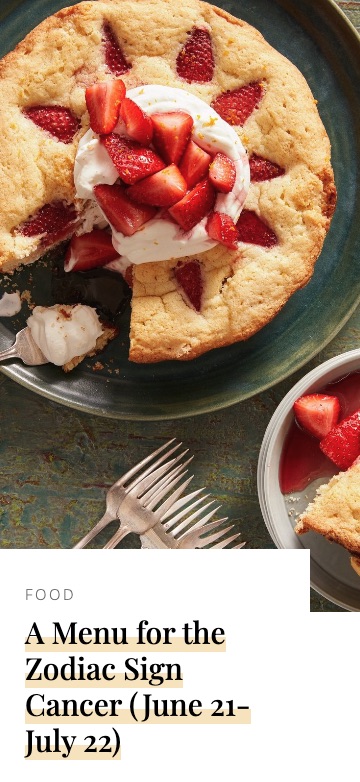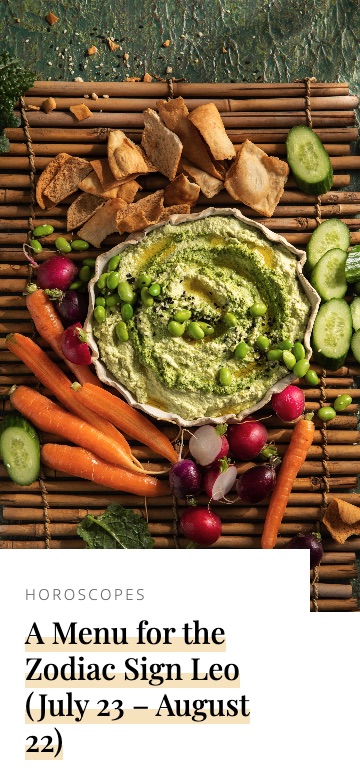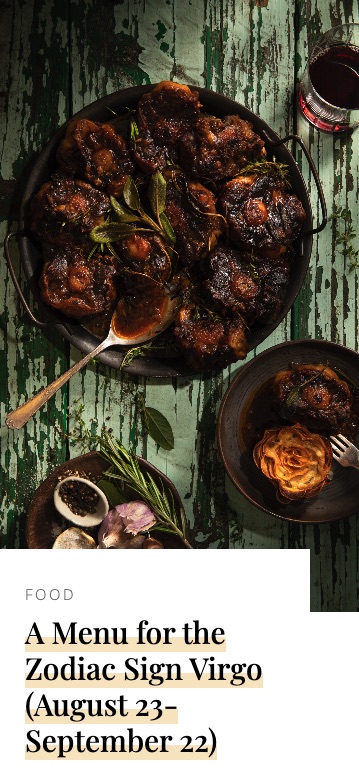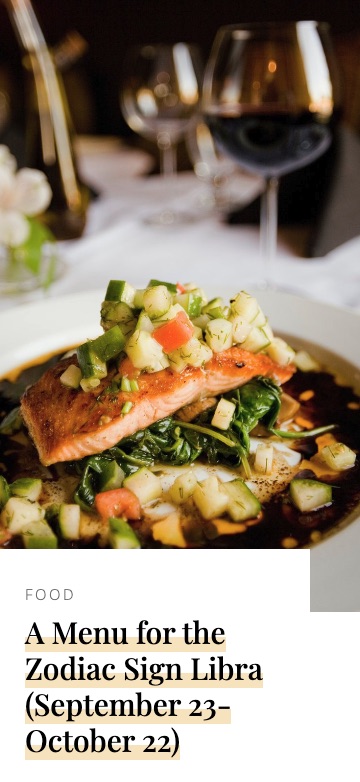
Astrology in the Culinary World
The intricate connection between astrology and culinary practices stretches back to ancient times, when food when considered both sustenance and medicine. This relationship is rooted in the theories of temperament and humor, which have shaped both medical and gastronomic thought for centuries (even providing the inspiration for major personality tests like the Myers Briggs). Historically, foods were not merely categorized by their taste or nutritional value, but by their humoral qualities – i.e., heating or cooling, moistening or drying.
While more modern forms of astrology have veered from this, traditional astrological methods retain this connection with humoral qualities. The four elements – fire, water, air, and earth – are the products of specific combinations of qualities. Fire results from heat and dryness, water from coldness and moisture, air from moisture and heat, and earth from coldness and dryness. These humoral qualities are embedded in the astrological signs and the seven visible planets.
Qualities of the zodiac signs
The fire signs: Aries, Leo, Sagittarius
The fire signs – Aries, Leo, and Sagittarius – are associated with the choleric temperament. To the ancients, the word ‘choleric’ evoked a vivid image of a passionate, energetic, and often impulsive individual. They believed that people of this temperament had an excess of yellow bile in the body, making them prone to anger and enthusiasm in equal measure. In terms of personality, cholerics were seen as natural leaders, driven by ambition and a desire for action. They were thought to be warm-blooded, quite literally, with a tendency towards feverishness and inflammation.
Ancients believed that choleric individuals should consume cooling and moistening foods to balance their fiery nature. However, they also recognized that cholerics thrived on stimulation, both mental and physical. Thus, their diet often included spicy dishes that matched their zestful personalities, red meats to fuel their energy, and stimulating herbs to enhance their natural vitality. The connection between food and temperament was seen as crucial for maintaining health and harmony within the body.
The water signs: Cancer, Scorpio, Pisces
Water signs – Cancer, Scorpio, and Pisces – comprise the phlegmatic temperament. These individuals were believed to be calm, intuitive, and emotionally attuned. The ancients associated them with coldness and moisture, reflecting the fluid and adaptable nature of water. Phlegmatics were thought to benefit from warming and drying foods to balance their cool, moist nature. Their diet often included hydrating fruits to maintain their natural affinity with water, leafy greens for nourishment, and fish to honor their connection to the aquatic.
For the phlegmatic temperament, the ancients prescribed a diet that would counterbalance their cold and moist nature. They believed phlegmatics needed warming and drying foods to invigorate their systems and prevent excess lethargy or melancholy. Their recommended diet often included warming spices like ginger and cinnamon to stimulate the body, lean proteins to provide sustained energy without heaviness, and roasted vegetables to impart both warmth and earthiness. Phlegmatics were advised to avoid excessive amounts of cold, raw foods and to limit dairy, which was thought to increase mucus production – a condition already prevalent in their constitution.
The air signs: Libra, Gemini, Aquarius
The air signs – Gemini, Libra, and Aquarius – correspond to the sanguine temperament. In ancient thought, sanguine individuals were characterized by their sociability, optimism, and intellectual curiosity. They were associated with warmth and moisture, reflecting the life-giving qualities of spring air. The ideal diet for sanguines was believed to include light, easily digestible meals that wouldn’t weigh down their active minds, as well as brain-boosting nuts to fuel their intellectual pursuits.
Ancients believed sanguines needed a balanced diet to maintain their naturally robust health and prevent overexcitement. They were advised to consume foods that were neither too heating nor too cooling. Fresh fruits and vegetables were recommended to support their active lifestyle, while complex carbohydrates like whole grains were suggested to sustain their energy and mental acuity. Sanguines were encouraged to enjoy a variety of flavors and textures, mirroring their love for diversity in life. However, they were cautioned against overindulgence in rich foods or alcohol, which could disturb their already vivacious nature.
The earth signs: Taurus, Virgo, Capricorn
Earth signs – Taurus, Virgo, and Capricorn – are linked to the melancholic temperament. The ancients viewed melancholics as practical, stable, and grounded individuals, much like the earth itself. They were associated with coldness and dryness, qualities that were believed to make them prone to pensiveness and caution. To balance these qualities, melancholics were advised to consume warming and moistening foods. Their diet often featured root vegetables to honor their connection to the earth, whole grains for sustained energy, and hearty stews to provide comfort and nourishment.
Melancholics were advised to consume warming and moistening foods to lift their spirits and combat their tendency towards pessimism and physical stagnation. Their diet often included nourishing soups and stews, which provided both warmth and hydration. Healthy fats from sources like olive oil and avocados were recommended to lubricate their dry constitution. Melancholics were also encouraged to incorporate sweet fruits and root vegetables into their diet, as these were believed to have a grounding yet gently uplifting effect. They were advised to avoid excessive amounts of cold, dry foods like crackers or raw vegetables, which could exacerbate their innate tendencies.
Qualities of the planets
The influence of planets on this culinary-astrological system adds another layer of complexity. The Sun and Moon, the luminaries of our solar system, were seen as particularly significant. The Sun, hot and dry, was associated with vitality-boosting foods like citrus fruits and sunflower seeds. The Moon, cold and wet, was linked to comforting, hydrating foods such as melons and dairy products. This pairing reflected the ancient understanding of balance and opposition in nature.
Jupiter and Venus were seen as benefic planets, each with its own influence on diet. Jupiter, temperately warm and moist, was connected to nourishing, expansive foods like figs and nuts, reflecting its association with growth and abundance. Venus, gently moistening and adaptable, was associated with sweet, harmonizing foods such as apples and honey, mirroring its connection to pleasure and harmony.
Saturn and Mars, often considered more challenging influences, also had their place in this system. Saturn, excessively cold and dry, was linked to astringent, structuring foods like beans and dark leafy greens, reflecting its association with discipline and limitation. Mars, excessively hot and dry, was associated with spicy, energizing foods such as chilies and garlic, mirroring its connection to passion and action.
Mercury, known for its adaptability, was believed to take on the qualities of the planets nearest to it in a given astrological chart. This flexible nature was reflected in its varied influence on food choices, adapting to the needs of the individual based on their unique astrological makeup.
One size can't fit all
An individual’s astrological makeup is more complex than just their Sun sign, Moon sign, or season of birth. A person born with a strong or dominant planet, or a particularly powerful configuration of planets, may find that their temperament reflects more of these influences than their ‘big three’ might reflect.
For example, someone who has many indicators of cold in their chart may find this tendency lessened if the Sun or Mars is on the horizon at their birth, due to the heating influence of these planets. Similarly, a person with a Libra Sun sign might typically be associated with the sanguine temperament, but if they have a prominent Saturn in their chart, they might respond to food more like a melancholic person.
This complexity extends to dietary considerations as well. While general astrological guidelines for food and diet by zodiac sign can be helpful for broad recommendations, they may not capture the full picture of an individual’s needs. For this reason, it is advised to use general astrological dietary guidelines for general purposes – and to schedule time with a qualified astrologer if you’d like to have a personalized understanding of your own constitution and temperamental makeup. An experienced astrologer can provide insights into the unique interplay of planetary influences in your birth chart, offering more tailored dietary and lifestyle recommendations that align with your specific astrological profile.
Menu by zodiac sign
I have been partnering with Table Magazine to issue a series about food and diet by zodiac sign. Below are those that have been published thus far, with details on qualities of foods and drink (warming and cooling, moistening and drying), and recipe ideas from the Table recipe team.
This page will be regularly updated with new articles as they are published each month with Table Magazine. To stay informed about the latest articles about astrology in the culinary world, subscribe to my mailing list using the form below.







